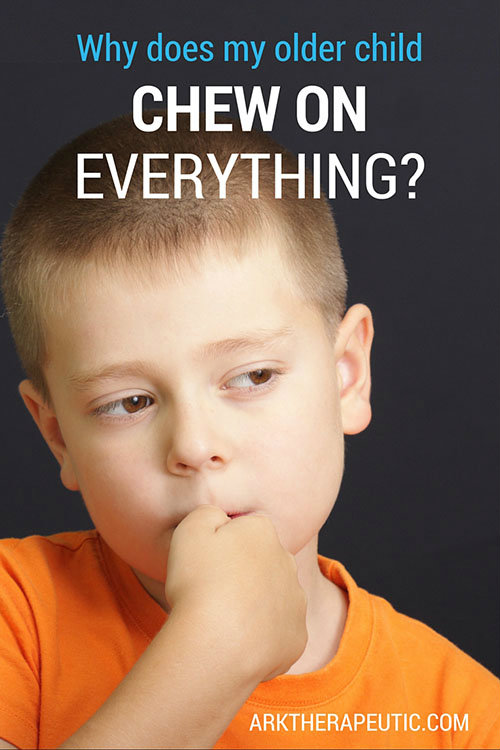Why does my toddler chew on everything? Toddlers chew on everything for a variety of reasons, including teething, exploring their environment, seeking sensory input, dealing with anxiety, or developing oral motor skills. This behavior is usually normal, but excessive or persistent chewing might need attention. Let’s delve into the reasons behind this common toddler behavior and explore some effective solutions.

Image Source: www.arktherapeutic.com
Decoding the Chewing Conundrum: What’s Behind the Behavior?
It can be frustrating when your little one seems to have a constant need to gnaw on things. From toys to furniture to their own hands, the chewing can feel relentless. Fortunately, there are often very logical reasons for this behavior.
Teething Troubles: A Common Culprit
Teething is a primary reason why many toddlers chew. This discomfort often begins around 6 months but continues intermittently throughout the toddler years as molars and other teeth erupt.
- What is teething? Teething is the process of new teeth pushing through the gums.
- How does it cause chewing? The pressure of new teeth emerging can cause pain and discomfort. Chewing provides counter-pressure, which can temporarily relieve the aching sensation.
Signs Your Toddler is Teething:
- Increased drooling
- Swollen or tender gums
- Irritability or fussiness
- Chewing on objects more than usual
- Slightly elevated temperature (low-grade fever)
- Rubbing their face or pulling their ears
Sensory Exploration: Discovering the World Through the Mouth
Toddlers use their mouths to explore and learn about the world around them. This oral exploration is a crucial part of their sensory development.
- What is sensory exploration? It’s the way young children learn about their environment using their senses: sight, sound, touch, taste, and smell.
- Why the mouth? The mouth is highly sensitive and packed with nerve endings, making it an ideal tool for toddlers to gather information about texture, shape, and size. This is a key aspect of toddler chewing development.
Seeking Sensory Input: The Calming Power of Chewing
Some toddlers chew to seek out sensory input. This is often referred to as seeking oral sensory input. Chewing can be a self-soothing behavior that helps them regulate their emotions or calm their nervous system. This is particularly relevant to toddler chewing sensory needs.
- What is sensory input? Sensory input refers to the information our brains receive from our senses.
- How does chewing provide it? The act of chewing can be rhythmic and repetitive, providing a calming effect. The pressure and sensation in the jaw can be comforting for some children.
Emotional Factors: Anxiety and Stress Relief
Chewing can also be a way for toddlers to cope with anxiety, stress, or boredom. Just like some adults might bite their nails when nervous, toddlers may turn to chewing.
- Can I relate chewing to emotions? Absolutely. Changes in routine, new environments, or separation anxiety can all trigger increased chewing.
- What are the signs of stress in toddlers? Increased clinginess, difficulty sleeping, changes in appetite, and increased tantrums can be signs of stress.
Developing Oral Motor Skills: Strengthening Muscles
Chewing helps to develop oral motor skills. These skills are important for speech development and eating. The mouth and jaw get stronger with all the chewing. This falls under toddler chewing development.
- What are oral motor skills? Oral motor skills involve the movement and coordination of the muscles in the mouth, including the lips, tongue, and jaw.
- How does chewing help? Chewing strengthens these muscles, improving a child’s ability to form sounds and chew food properly.
Habits: The Power of Repetition
Sometimes, toddler excessive chewing becomes a habit. Once a behavior is established, it can be hard to break, even if the initial cause is no longer present. The toddler constantly chewing may be due to habit.
- How do habits form? Habits are formed through repetition. The more a child chews, the more ingrained the behavior becomes.
- How can I break the habit? Interruption is key. You need to redirect the behavior with other activities, toys, or a safe alternative to chew on.
Troubleshooting Chewing: Solutions for Your Gnawing Toddler
While chewing is often a normal part of toddler development, it’s still important to address the behavior, especially if it’s causing concern. Here are some effective solutions:
Providing Safe Chewing Alternatives: Redirecting the Urge
The most straightforward solution is to offer safe and appropriate items for your toddler to chew on.
- Chew Toys: Invest in a variety of chew toys designed for toddlers. Look for different textures and shapes to provide varied sensory experiences.
- Teething Toys: If teething is the primary cause, focus on teethers that can be chilled for extra relief.
- Silicone Jewelry: Chewable silicone necklaces or bracelets are a discreet option for toddlers who like to chew on clothing or their hands.
- Frozen Washcloths: Soak a clean washcloth in water, twist it, and freeze it. The cold provides soothing relief for teething gums.
Safe Chewing Toy Features
| Feature | Description |
|---|---|
| Non-toxic | Must be made of materials that are safe if ingested (e.g., food-grade silicone) |
| Durable | Should be able to withstand repeated chewing without breaking into small pieces |
| Easy to Clean | Should be easy to wash and sanitize to prevent the spread of germs |
| Appropriate Size | Not too small to pose a choking hazard, but not too large for the child to handle |
| Different Textures | Offer varied sensory experiences, such as bumpy, ribbed, or smooth surfaces |
Addressing Teething Discomfort: Soothing Sore Gums
If teething is the main culprit, focus on providing relief for your toddler’s sore gums. This offers excellent toddler chewing relief.
- Cold Compresses: Gently massage your toddler’s gums with a cold, damp cloth or your finger.
- Teething Gels: Use a teething gel specifically designed for infants and toddlers. Consult your pediatrician before using any medication.
- Pain Relievers: If your toddler is very uncomfortable, ask your doctor about giving them a child-safe pain reliever like acetaminophen or ibuprofen.
Managing Sensory Needs: Meeting the Sensory Input
If your toddler is chewing to seek sensory input, try to identify other ways to meet their sensory needs.
- Sensory Activities: Provide opportunities for sensory play, such as playing with playdough, water, sand, or textured fabrics.
- Oral Motor Activities: Encourage activities that involve using the mouth and jaw muscles, such as blowing bubbles, drinking through a straw, or eating crunchy foods.
- Deep Pressure: Gentle pressure can be calming. Offer hugs, swaddle your toddler (if they still enjoy it), or use a weighted blanket during quiet time.
Dealing with Emotional Issues: Reducing Anxiety
If you suspect that chewing is related to anxiety or stress, address the underlying emotional issues.
- Identify Triggers: Pay attention to when your toddler chews more frequently. Are there specific situations or events that trigger the behavior?
- Create a Calming Routine: Establish a consistent daily routine with predictable activities to provide a sense of security.
- Provide Reassurance: Offer plenty of cuddles, praise, and reassurance to help your toddler feel safe and loved.
- Talk About Feelings: Help your toddler learn to identify and express their feelings.
- Seek Professional Help: If anxiety is severe or persistent, consider consulting a child psychologist or therapist.
Breaking the Habit: Positive Reinforcement
Once chewing becomes a habit, it can be challenging to break. Use positive reinforcement to encourage alternative behaviors.
- Redirection: When you see your toddler chewing on something inappropriate, gently redirect them to a safe chewing toy or activity.
- Positive Reinforcement: Praise and reward your toddler when they choose to chew on appropriate items or engage in other activities instead of chewing.
- Avoid Punishment: Punishing your toddler for chewing will likely increase their anxiety and make the behavior worse.
- Consistency: Be consistent with your approach. It takes time and patience to break a habit.
Consulting a Professional: When to Seek Advice
In most cases, toddler chewing is a normal and temporary behavior. However, there are situations when it’s important to seek professional advice.
- Excessive or Compulsive Chewing: If your toddler is chewing constantly and it’s interfering with their daily life, consult your pediatrician.
- Damage to Teeth or Gums: If chewing is causing damage to your toddler’s teeth or gums, see a dentist.
- Suspected Sensory Processing Issues: If you suspect your toddler has sensory processing issues, talk to your pediatrician or an occupational therapist.
- Emotional or Behavioral Concerns: If you’re concerned about your toddler’s emotional or behavioral development, consult a child psychologist or therapist.
More Tips for Success: Creating a Safe & Supportive Environment
- Keep Hazardous Materials Out of Reach: Ensure that your toddler cannot access potentially dangerous items, such as cleaning supplies, medications, or small objects that could be a choking hazard.
- Supervise Playtime: Closely supervise your toddler during playtime to prevent them from chewing on inappropriate items.
- Clean Toys Regularly: Wash toys regularly to prevent the spread of germs.
- Be Patient: Remember that chewing is often a temporary phase. With patience, understanding, and the right strategies, you can help your toddler manage this behavior.
Fathoming the Oral Stage: Freud’s Perspective
It’s worth briefly touching upon the psychoanalytic perspective. Sigmund Freud theorized that toddlers are in the “oral stage” of development. During this stage, the mouth is the primary source of pleasure and exploration. Chewing, sucking, and biting are all normal behaviors associated with this stage. While Freud’s theories are not universally accepted, they provide another lens through which to view toddler oral fixation.
FAQ: Addressing Common Concerns
- Is chewing on clothes normal? Yes, chewing on clothes is common, especially during teething or when seeking sensory input. Provide a safe alternative like a chewable necklace.
- My toddler is chewing on wood furniture. What should I do? Clean the furniture thoroughly and cover it with a protective layer if possible. Offer a safe chewing toy instead.
- How long does the chewing phase last? The chewing phase varies. Teething-related chewing may come and go, while sensory-seeking chewing might last longer. Monitor the behavior and seek professional advice if concerned.
- What is pica? Pica is a condition where a person craves and chews on non-food items like dirt, paint, or metal. If you suspect your toddler has pica, consult your pediatrician immediately.
- Can I stop my toddler from chewing cold turkey? It’s best to gently redirect the behavior with alternatives and address the underlying cause, rather than stopping it abruptly.
- Does chewing indicate a nutritional deficiency? Sometimes, pica (chewing on non-food items) can be a sign of a nutritional deficiency, such as iron deficiency. Talk to your doctor.
- Are certain kids more prone to chewing? Children with sensory processing differences or anxiety may be more prone to chewing.
By recognizing the various reasons behind your toddler’s chewing behavior and implementing the appropriate solutions, you can help them navigate this phase successfully and ensure their safety and well-being. Remember to stay patient and consult professionals when needed. This will help you with finding the best toddler chewing solutions.

Clark Lubowitz is a parenting expert with over 10 years of experience in toddler care and child development. Holding a degree in Early Childhood Education, he specializes in blending modern technology with parenting, offering expert advice on the best toddler gadgets. Through his work on ToddlerAwesome.com, Clark provides valuable insights to help parents make informed decisions for their little ones.
